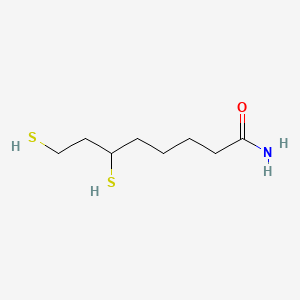| MeSH term | MeSH ID | Detail |
|---|---|---|
| Parkinsonian Disorders | D020734 | 20 associated lipids |
Dihydrolipoamide
Dihydrolipoamide is a lipid of Fatty Acyls (FA) class. Dihydrolipoamide is associated with abnormalities such as Wiskott-Aldrich Syndrome. The involved functions are known as Citric Acid Cycle, Electron Transport, NADH oxidation, Oxidation and Oxidants. Dihydrolipoamide often locates in Mitochondria, Mitochondrial matrix and Chloroplasts. The associated genes with Dihydrolipoamide are Mutant Proteins, Recombinant Proteins, mycothione reductase, Genes, Mitochondrial and alanylproline.
Cross Reference
Introduction
To understand associated biological information of Dihydrolipoamide, we collected biological information of abnormalities, associated pathways, cellular/molecular locations, biological functions, related genes/proteins, lipids and common seen animal/experimental models with organized paragraphs from literatures.
What diseases are associated with Dihydrolipoamide?
Dihydrolipoamide is suspected in and other diseases in descending order of the highest number of associated sentences.
Related references are mostly published in these journals:
| Disease | Cross reference | Weighted score | Related literature |
|---|
Possible diseases from mapped MeSH terms on references
We collected disease MeSH terms mapped to the references associated with Dihydrolipoamide
PubChem Associated disorders and diseases
What pathways are associated with Dihydrolipoamide
There are no associated biomedical information in the current reference collection.
PubChem Biomolecular Interactions and Pathways
Link to PubChem Biomolecular Interactions and PathwaysWhat cellular locations are associated with Dihydrolipoamide?
Visualization in cellular structure
Associated locations are in red color. Not associated locations are in black.
Related references are published most in these journals:
| Location | Cross reference | Weighted score | Related literatures |
|---|
What functions are associated with Dihydrolipoamide?
Related references are published most in these journals:
| Function | Cross reference | Weighted score | Related literatures |
|---|
What lipids are associated with Dihydrolipoamide?
There are no associated biomedical information in the current reference collection.
What genes are associated with Dihydrolipoamide?
Related references are published most in these journals:
| Gene | Cross reference | Weighted score | Related literatures |
|---|
What common seen animal models are associated with Dihydrolipoamide?
There are no associated biomedical information in the current reference collection.
NCBI Entrez Crosslinks
All references with Dihydrolipoamide
Download all related citations| Authors | Title | Published | Journal | PubMed Link |
|---|---|---|---|---|
| Hussain SN et al. | Modifications of proteins by 4-hydroxy-2-nonenal in the ventilatory muscles of rats. | 2006 | Am. J. Physiol. Lung Cell Mol. Physiol. | pmid:16603597 |
| pmid:16669652 | ||||
| Smolle M et al. | A new level of architectural complexity in the human pyruvate dehydrogenase complex. | 2006 | J. Biol. Chem. | pmid:16679318 |
| Lee H et al. | An integrated approach to the prediction of domain-domain interactions. | 2006 | BMC Bioinformatics | pmid:16725050 |
| pmid:16729985 | ||||
| Bunik VI et al. | Brain pyruvate and 2-oxoglutarate dehydrogenase complexes are mitochondrial targets of the CoA ester of the Refsum disease marker phytanic acid. | 2006 | FEBS Lett. | pmid:16737698 |
| pmid:16770810 | ||||
| pmid:16814740 | ||||
| pmid:16835851 | ||||
| pmid:16855207 | ||||
| pmid:16861247 | ||||
| Boucher IW et al. | Structural and biochemical characterization of a mitochondrial peroxiredoxin from Plasmodium falciparum. | 2006 | Mol. Microbiol. | pmid:16879648 |
| Brown RM et al. | Pyruvate dehydrogenase E3 binding protein (protein X) deficiency. | 2006 | Dev Med Child Neurol | pmid:16904023 |
| Liu DQ et al. | [Microwave coagulation at different temperatures for hepatocellular carcinoma management: efficacy evaluation by enzyme histochemical staining]. | 2006 | Nan Fang Yi Ke Da Xue Xue Bao | pmid:16939906 |
| pmid:16945443 | ||||
| pmid:17017892 | ||||
| pmid:17033778 | ||||
| Lee EH et al. | A Korean female patient with thiamine-responsive pyruvate dehydrogenase complex deficiency due to a novel point mutation (Y161C)in the PDHA1 gene. | 2006 | J. Korean Med. Sci. | pmid:17043409 |
| pmid:17052205 | ||||
| Kunieda T et al. | Carbohydrate metabolism genes and pathways in insects: insights from the honey bee genome. | 2006 | Insect Mol. Biol. | pmid:17069632 |
